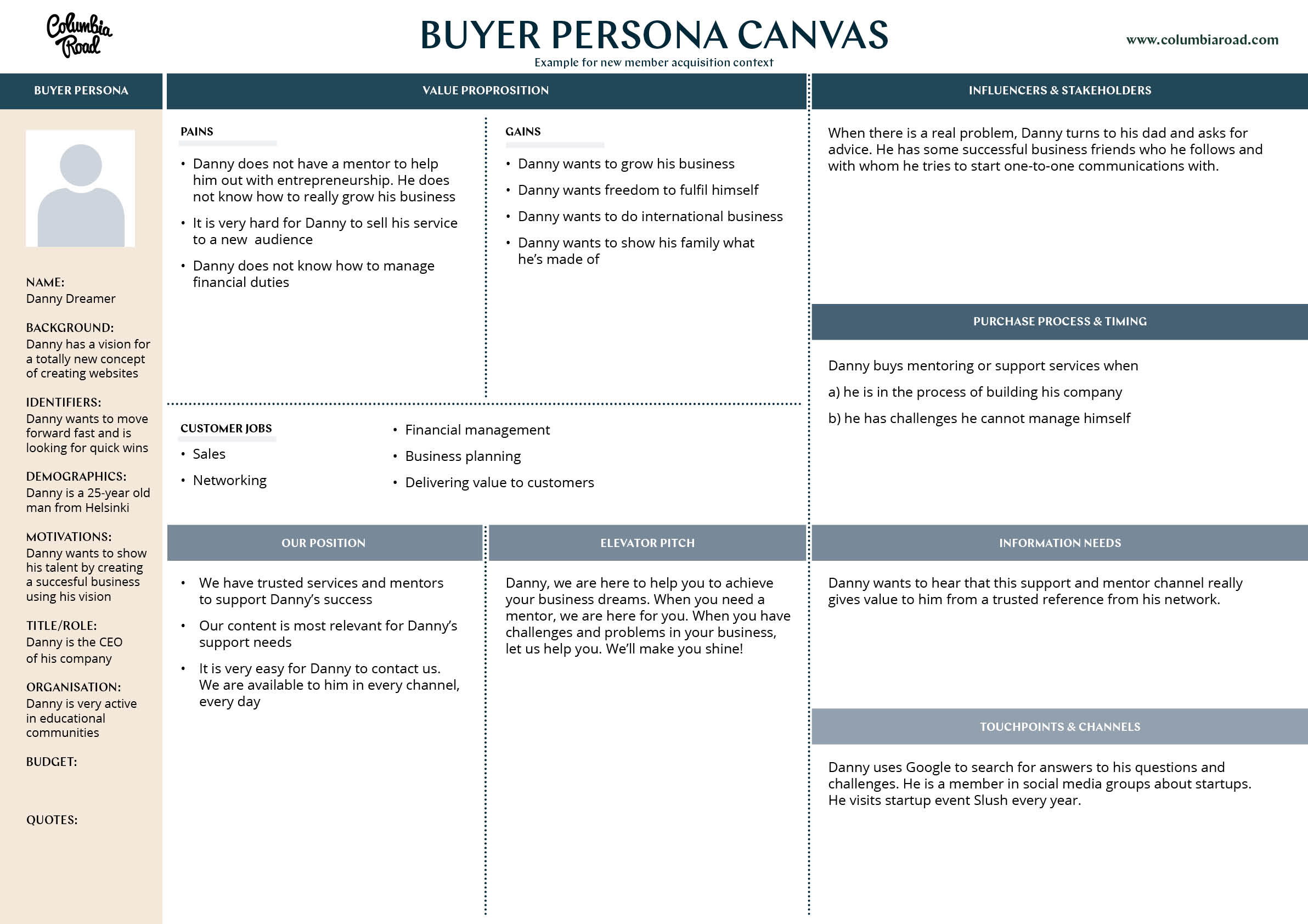The Data Handbook
How to use data to improve your customer journey and get better business outcomes in digital sales. Interviews, use cases, and deep-dives.
Get the bookWhy should you define buyer personas? Well, we think it's the best way to dive deep into human pains and gains and map them into your value proposition.
Thanks to the content marketing boom, humans and their pains and gains are now the key drivers of companies’ marketing content. More and more, creating buyer personas is the starting point of every content strategy. And when companies commit to strategy, content and marketing actions help target specific audiences and drive more revenue.
It’s worth noting that marketing is just one area where it is critical to use buyer personas. Sales channels and customer experience development need an understanding of the customer as well. In other words: Defining buyer personas is the starting point of every process which aims to generate growth.
In today’s content-fatigued, craving-a-personal-touch marketplace, a buyer persona works so much better than just segmenting your audience by demographic attributes. Instead of grouping buyers into buckets, a detailed buyer persona paints a picture of an individual buyer. Someone who could (and might) exist in real life.
What was once an exercise only practised by large companies is becoming increasingly useful for smaller online retailers. There are a few reasons for this. First, as the online space becomes more and more crowded, it’s becoming increasingly important to have ultra-targeted value propositions, content, ads and communication methods.
Additionally, the tools to target customers have been democratised to a point where everyone can create campaigns to target customers based on an ever-growing list of demographics and psychographics. You don’t need to do big segmentation exercises from your own data to start doing data-driven marketing and sales.
According to a study from Mark W. Schaefer, three to four buyer personas usually account for over 90% of a company’s sales.
Well, how to map those buyer personas then?
1. Learn from current Customer Data
Look at real data from current customers, or interview current customers.
Customer service and sales teams often have heaps of buyer data you can browse through. So interview your own experts.
If you have demographics and interest reports enabled in Google Analytics, you can pull insightful audience reports.
2. Carry out market research
When creating a buyer persona, you're essentially creating a personality that embodies a key segment of your audience - and the first step to accomplishing this is to conduct thorough research. To get an estimate of who your customers are, what they want, and what they're looking for, you might need to hold surveys and polls via your social media channels and look at your competitors to see how their customers interact with them online; this will help you gain a better understanding of who you're speaking to on your channels.
3. Check your site analytics
More data has been created in the last two years than in the whole previous history of the human race. That’s a lot of data. You can harness that data to strategically focus your marketing efforts and reach out to your customers in a valuable way.
Inside your site analytics, you'll be able to see where your site visitors came from, the keywords they used to find you, and how long they stayed on site once they arrived. This type of data is essential to creating buyer personas as it shows the search terms that led your audience to your site, as well as the devices and platforms they used to get there.
4. Discover where your customers are hanging out
Put yourself in your customers’ shoes. Think of where they hang out online and in person. We’re talking forums, events, organisations – even the videos they watch on YouTube and comment on. Then, spend time there listening.
5. Most important: Talk both to your existing customers and the customers you aim to acquire
If you have limited time for creating buyer personas, start from this!
To understand your personas’ psychographics in depth, your best bet is to talk to both your existing customers and customers you want to have. The most effective way to do this research is to meet them face-to-face or pick up the phone and call them.
During an interview try to discuss real-life challenges or successes your persona has encountered. From actual situations, you get deeper insight about pains and how your persona has solved those. Consider every question and try to understand why your persona acted as she/he did. Human stories about challenges, successes, and customer jobs-to-be-done are key to clarify your value proposition.
6. Place both value proposition and buyer persona on the same canvas
Bring your company’s value proposition on the same page with buyer personas. This way, you can see the coherent picture where your value proposition, position, touchpoints and channels line up with the buyer persona’s pains, gains and customer jobs to be done.
What to do next after you have defined the first buyer personas?
By mapping your business' customer journeys, you'll be able to pinpoint pain points and areas of success, both for your customers and within your organisation. Take a step towards creating an innovative customer experience that adds value to your business and feels valued by your customers.
We recommend that in order to prioritise growth development, it is wise to first create buyer personas and then move on to creating customer journey maps for those personas. Personas have a crucial role to play in the increasingly important discipline of customer journey mapping. Personas and journey maps together help shift companies’ focus from inside-out to outside-in. Personas describe in detail who your key customers are and why they feel the ways they do.
Personas are the starting point for a successful customer journey map. A customer journey explains what happens along the way, to whom, and how it happens – which is why you need to know who is embarking on the journey.
Get the canvas
The Customer Journey Map
Get your copy of the Customer Journey Map template. By mapping your business' customer journeys, you'll be able to pinpoint pain spots and areas of success, both for your customers and within your organisation.
Get the canvas




